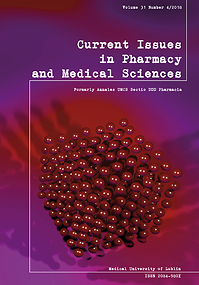Sever hepatitis induced by Epstein-Barr virus: case series
DOI:
https://doi.org/10.1515/cipms-2018-0010Keywords:
Epstein-Barr virus, hepatitis, serologic testsAbstract
Epstein-Barr virus (EBV) is a causative agent of infectious mononucleosis syndrome. This infection often resolves over a period of several months without outcomes, but may occasionally be complicated by a great variety of neurologic, hepatic, hematologic and respiratory complications. In the current report, we present the case histories of three patients with acute hepatitis following EBV infection when previously healthy. The patients showed fever, nausea, weakness, as well as yellowing of the skin, and then in the course of examination, sore throat. They were managed supportively and their clinical condition improved. Liver function tests such as ALT, AST, ALP, were undertaken and bilirubin were elevated. The serological tests for EBV infection were consistent with the acute phase of infection. The monospot test was also positive. The patients were managed supportively, and their critical condition was improved.References
1. Cohen JI. Optimal Treatment for Chronic Active Epstein-Barr Virus Disease. Pediatr transplant. 2009;13:393. Google Scholar
2. Leonardsson H et al. Hepatitis due to Epstein–Barr virus and cytomegalovirus: clinical features and outcomes. Scand J Gastroenterol. 2017;52:893. Google Scholar
3. Kofteridis DP et al. Epstein Barr virus hepatitis. Eur J Intern Med. 2011;22:73. Google Scholar
4. Oh SH et al. A Case of Ulcerative Colitis Following Acute Hepatitis Induced by Epstein-Barr Virus Infection. Korean J Gastroenterol. 2016;68:104. Google Scholar
5. Petrova M, Kamburov V. Epstein-Barr virus: Silent companion or causative agent of chronic liver disease? World J. Gastroenterol. 2010;16:4130. Google Scholar
6. Yang SI et al. Clinical Characteristics of Primary Epstein Barr Virus Hepatitis with Elevation of Alkaline Phosphatase and γ-Glutamyltransferase in Children. Yonsei Med J. 2014;55:107. Google Scholar
7. Zhang W et al. Epstein-Barr Virus-Associated Acute Liver Failure Present in a 67-Year-Old Immunocompetent Female. Gastroenterol Res. 2016;9:74. Google Scholar
8. Xing Y et al. Chronic active Epstein-Barr virus infection associated with hemophagocytic syndrome and extra-nodal natural killer.T-cell lymphoma in an 18-year-old girl: A case report. Medicine (Baltimore),96,2017. Google Scholar
9. Lawee D. Mild infectious mononucleosis presenting with transient mixed liver disease: Case report with a literature review. Can Fam Physician. 2007;53:1314. Google Scholar
10. Packman CH. The Clinical Pictures of Autoimmune Hemolytic Anemia. Transfus Med Hemother. 2015;42:317. Google Scholar
11. Becker JA, Smith JA. Return to Play After Infectious Mononucleosis. Sports Health 2014;6:232. Google Scholar
12. Malhotra V et al. Infectious mononucleosis with secondary cold agglutinin disease causing autoimmune haemolytic anaemia. BMJ Case Rep, 2009;bcr12.2008.1390. Google Scholar
13. Demirdal T, Dermirtuk N. A rare presentation on EBV hepatitis. Eur J Gen Med. 2007;4:33. Google Scholar
14. Corrales I et al. Evaluation of the Architect Epstein-Barr Virus (EBV) viral capsid antigen (VCA) IgG, VCA IgM, and EBV nuclear antigen 1 IgG chemiluminescent immunoassays for detection of EBV antibodies and categorization of EBV infection status using immunofluorescence assays as the reference method. Clin Vaccine Immunol. 2014;21:684. Google Scholar
15. Crum NF. Epstein Barr virus hepatitis: case series and review. South Med J. 2006;99:544. Google Scholar
Downloads
Published
Issue
Section
License
Copyright (c) 2018 Authors

This work is licensed under a Creative Commons Attribution-NonCommercial-NoDerivatives 3.0 Unported License.


